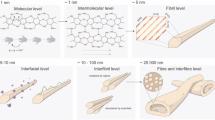Abstract
Most celluloses are soluble in 8 mass % lithium chloride/N,N-dimethylacetamide (LiCl/DMAc) and/or 8 mass % LiCl/1,3-dimethyl-2-imidazolidinone (LiCl/DMI) with solvent-exchange treatment from water to DMAc or DMI through acetone. In this study, the residual DMAc or DMI adsorbed on celluloses after the solvent-exchange and then vacuum-drying at 60 °C for 48 h was determined by UV spectroscopy and elementary analysis. Significant amounts of DMI or DMAc remain in the solvent-exchanged celluloses even after vacuum drying: about 1.2 mmol/g and 1.0 mmol/g for DMI and DMAc, respectively. Thus, corrections of molecular-mass parameters of celluloses, which were reported in previous literatures based on the assumption that no residual amides are present in the solvent-exchanged and then vacuum-dried celluloses, are needed.






Similar content being viewed by others
References
Ishii D, Tatsumi D, Matsumoto T (2003) Effect of solvent exchange on the solid structure and dissolution behavior of cellulose. Biomacromolecules 4:1238–1243
Ishii D, Kanazawa Y, Tatsumi D, Matsumoto T (2007) Effect of solvent exchange on the pore structure and dissolution behavior of cellulose. J Appl Polym Sci 103:3976–3984
Ishii D, Tatsumi D, Matsumoto T (2008) Effect of solvent exchange on the supramolecular structure, the molecular mobility and the dissolution behavior of cellulose in LiCl/DMAc. Carbohydr Res (in press) doi: 10.1016/j.carres.2008.01.035
Isogai A, Atalla RH (1998) Dissolution of cellulose in aqueous NaOH solutions. Cellulose 5:309–319
Heinze T, Liebert T (2001) Unconventional methods in cellulose functionalization. Prog Polym Sci 26:1689–1762
Matsumoto T, Tatsumi D, Tamai N, Takaki T (2002) Solution properties of celluloses from different biological origins in LiCl·DMAc. Cellulose 8:275–282
McCormick CL, Callais PA, Hutchinson BH Jr (1985) Solution studies of cellulose in lithium chloride and N,N-dimethylacetamide. Macromolecules 18:2394–2401
Potthast A, Rosenau T, Sixta H, Kosma P (2002) Degradation of cellulosic materials by heating in DMAc/LiCl. Tetrahedron Lett 43:7757–7759
Sjöholm E, Gustafsson K, Berthold F, Colmsjö A (2000) Influence of the carbohydrate composition on the molecular weight distribution of kraft pulps. Carbohydr Polym 41:1–7
Tamai N, Tatsumi D, Matsumoto T (2004) Rheological properties and molecular structure of tunicate cellulose in LiCl/1,3-dimethyl-2-imidazolidinone. Biomacromolecules 5:422–432
Turbak A (1984) Recent developments in cellulose solvent systems. Tappi J 67:94–96
Yanagisawa M, Shibata I, Isogai A (2004) SEC-MALLS analysis of cellulose using LiCl/1,3-dimethyl-2-imidazolidinone as an eluent. Cellulose 11:169–176
Yanagisawa M, Shibata I, Isogai A (2005a) SEC-MALLS analysis of softwood kraft pulp using LiCl/1,3-dimethyl-2-imidazolidinone as an eluent. Cellulose 12:151–158
Yanagisawa M, Isogai A (2005b) SEC-MALS-QELS study on the molecular conformation of cellulose in LiCl/amide solutions. Biomacromolecules 6:1258–1265
Zhang L, Ruan D, Zhou J (2001) Structure and properties of regenerated cellulose films prepared from cotton linters in NaOH/urea aqueous solution. Ind Eng Chem Res 40:5923–5928
Zhang L, Ruan D, Gao S (2002) Dissolution and regeneration of cellulose in NaOH/thiourea aqueous solution. J Polym Sci Polym Phys 40:1521–1529
Acknowledgments
This research was supported by a Grant-in-Aid for Young Scientists (Grant number 19-4140) from the Japan Society for the Promotion of Science (JSPS). The authors thank Mr. Takehiko Uematsu of our laboratory, who is a visiting researcher from Kao Corporation, Japan, for his help in determining nitrogen contents of celluloses.
Author information
Authors and Affiliations
Corresponding author
Rights and permissions
About this article
Cite this article
Ishii, D., Isogai, A. The residual amide content of cellulose sequentially solvent-exchanged and then vacuum-dried. Cellulose 15, 547–553 (2008). https://doi.org/10.1007/s10570-008-9211-y
Received:
Accepted:
Published:
Issue Date:
DOI: https://doi.org/10.1007/s10570-008-9211-y




